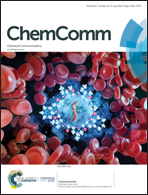Dual detection of bioaccumulated Hg2+ based on luminescent bacteria and aggregation-induced emission†
Abstract
The development of a sensitive and reliable method for the detection of bioaccumulated heavy metal toxins is highly desirable for biotoxicity evaluation. However, the conventional biotoxicity evaluation method based on luminescent bacteria suffers from only being able to detect the overall toxicity without selectivity in light-off detection mode. Although various synthetic fluorescent probes have been developed for the selective detection of heavy metal ions, they usually suffer from aggregation-caused quenching after local accumulation in biological systems. To tackle these challenges, we herein develop a dual detection strategy for bioaccumulated Hg2+ based on turn-off of the bioluminescence of P. phosphoreum bacteria by disrupting the quorum sensing system and turn-on of the photoluminescence of an aggregation-induced emission (AIE) probe by forming aggregates with Hg2+ inside the bacteria. It is expected that the dual detection strategy would find broad applications in the evaluation of bioaccumulated toxins.



 Please wait while we load your content...
Please wait while we load your content...